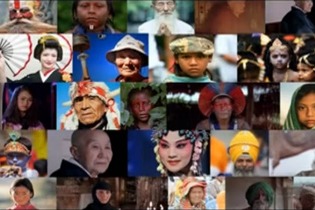Convention for the Safeguarding of the Intangible Cultural Heritage

Convention for the Safeguarding of the Intangible Cultural Heritage.pdf
Paris, 17 October 2003
The General Conference of the United Nations Educational, Scientific and Cultural Organization hereinafter referred to as UNESCO, meeting in Paris, from 29 September to 17 October 2003, at its 32nd session,
Referring to existing international human rights instruments, in particular to the Universal Declaration on Human Rights of 1948, the International Covenant on Economic, Social and Cultural Rights of 1966, and the International Covenant on Civil and Political Rights of 1966,
Considering the importance of the intangible cultural heritage as a mainspring of cultural diversity and a guarantee of sustainable development, as underscored in the UNESCO Recommendation on the Safeguarding of Traditional Culture and Folklore of 1989, in the UNESCO Universal Declaration on Cultural Diversity of 2001, and in the Istanbul Declaration of 2002 adopted by the Third Round Table of Ministers of Culture,
Considering the deep-seated interdependence between the intangible cultural heritage and the tangible cultural and natural heritage,
Recognizing that the processes of globalization and social transformation, alongside the conditions they create for renewed dialogue among communities, also give rise, as does the phenomenon of intolerance, to grave threats of deterioration, disappearance and destruction of the intangible cultural heritage, in particular owing to a lack of resources for safeguarding such heritage,
Being aware of the universal will and the common concern to safeguard the intangible cultural heritage of humanity,
Recognizing that communities, in particular indigenous communities, groups and, in some cases, individuals, play an important role in the production, safeguarding, maintenance and re-creation of the intangible cultural heritage, thus helping to enrich cultural diversity and human creativity,
Noting the far-reaching impact of the activities of UNESCO in establishing normative instruments for the protection of the cultural heritage, in particular the Convention for the Protection of the World Cultural and Natural Heritage of 1972,
Noting further that no binding multilateral instrument as yet exists for the safeguarding of the intangible cultural heritage,
Considering that existing international agreements, recommendations and resolutions concerning the cultural and natural heritage need to be effectively enriched and supplemented by means of new provisions relating to the intangible cultural heritage,
Considering the need to build greater awareness, especially among the younger generations, of the importance of the intangible cultural heritage and of its safeguarding,
Considering that the international community should contribute, together with the States Parties to this Convention, to the safeguarding of such heritage in a spirit of cooperation and mutual assistance,
Recalling UNESCO’s programmes relating to the intangible cultural heritage, in particular the Proclamation of Masterpieces of the Oral and Intangible Heritage of Humanity,
Considering the invaluable role of the intangible cultural heritage as a factor in bringing human beings closer together and ensuring exchange and understanding among them,
Adopts this Convention on this seventeenth day of October 2003.
I. General provisions
Article 1 – Purposes of the Convention
The purposes of this Convention are:
(a) to safeguard the intangible cultural heritage;
(b) to ensure respect for the intangible cultural heritage of the communities, groups and individuals concerned;
(c) to raise awareness at the local, national and international levels of the importance of the intangible cultural heritage, and of ensuring mutual appreciation thereof;
(d) to provide for international cooperation and assistance.
Article 2 – Definitions
For the purposes of this Convention,
1. The “Intangible Cultural Heritage” means the practices, representations, expressions, knowledge, skills – as well as the instruments, objects, artefacts and cultural spaces associated therewith – that communities, groups and, in some cases, individuals recognize as part of their cultural heritage. This intangible cultural heritage, transmitted from generation to generation, is constantly recreated by communities and groups in response to their environment, their interaction with nature and their history, and provides them with a sense of identity and continuity, thus promoting respect for cultural diversity and human creativity. For the purposes of this Convention, consideration will be given solely to such intangible cultural heritage as is compatible with existing international human rights instruments, as well as with the requirements of mutual respect among communities, groups and individuals, and of sustainable development.
2. The “Intangible Cultural Heritage”, as defined in paragraph 1 above, is manifested inter alia in the following domains:
(a) oral traditions and expressions, including language as a vehicle of the intangible cultural heritage;
(b) performing arts;
(c) social practices, rituals and festive events;
(d) knowledge and practices concerning nature and the universe;
(e) traditional craftsmanship.
3. “Safeguarding” means measures aimed at ensuring the viability of the intangible cultural heritage, including the identification, documentation, research, preservation, protection, promotion, enhancement, transmission, particularly through formal and non-formal education, as well as the revitalization of the various aspects of such heritage.
4. “States Parties” means States which are bound by this Convention and among which this Convention is in force.
5. This Convention applies mutatis mutandis to the territories referred to in Article 33 which become Parties to this Convention in accordance with the conditions set out in that Article. To that extent the expression “States Parties” also refers to such territories.
Article 3 – Relationship to other international instruments
Nothing in this Convention may be interpreted as:
(a) altering the status or diminishing the level of protection under the 1972 Convention concerning the Protection of the World Cultural and Natural Heritage of World Heritage properties with which an item of the intangible cultural heritage is directly associated; or
(b) affecting the rights and obligations of States Parties deriving from any international instrument relating to intellectual property rights or to the use of biological and ecological resources to which they are parties.

Address: 81, Laiguangying West Road, Chaoyang District, Beijing, China
Zip Code: 100021
Tel: 86-10-64966526
Fax: 86-10-64969281
E-mail: crihap@crihap.cn
Leave us your e-mail address, we'll let you know about current events.



